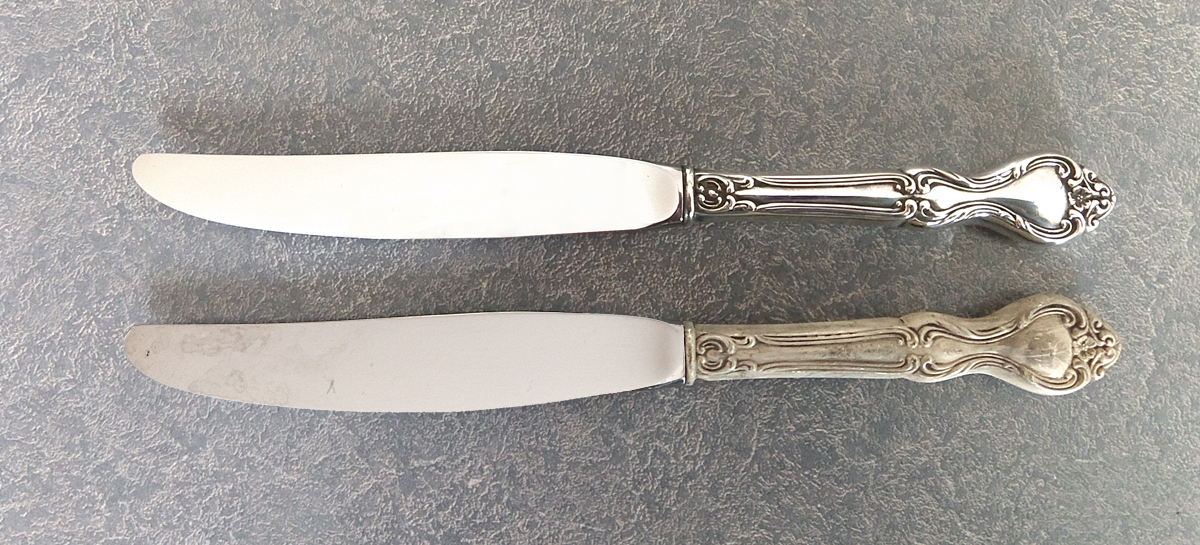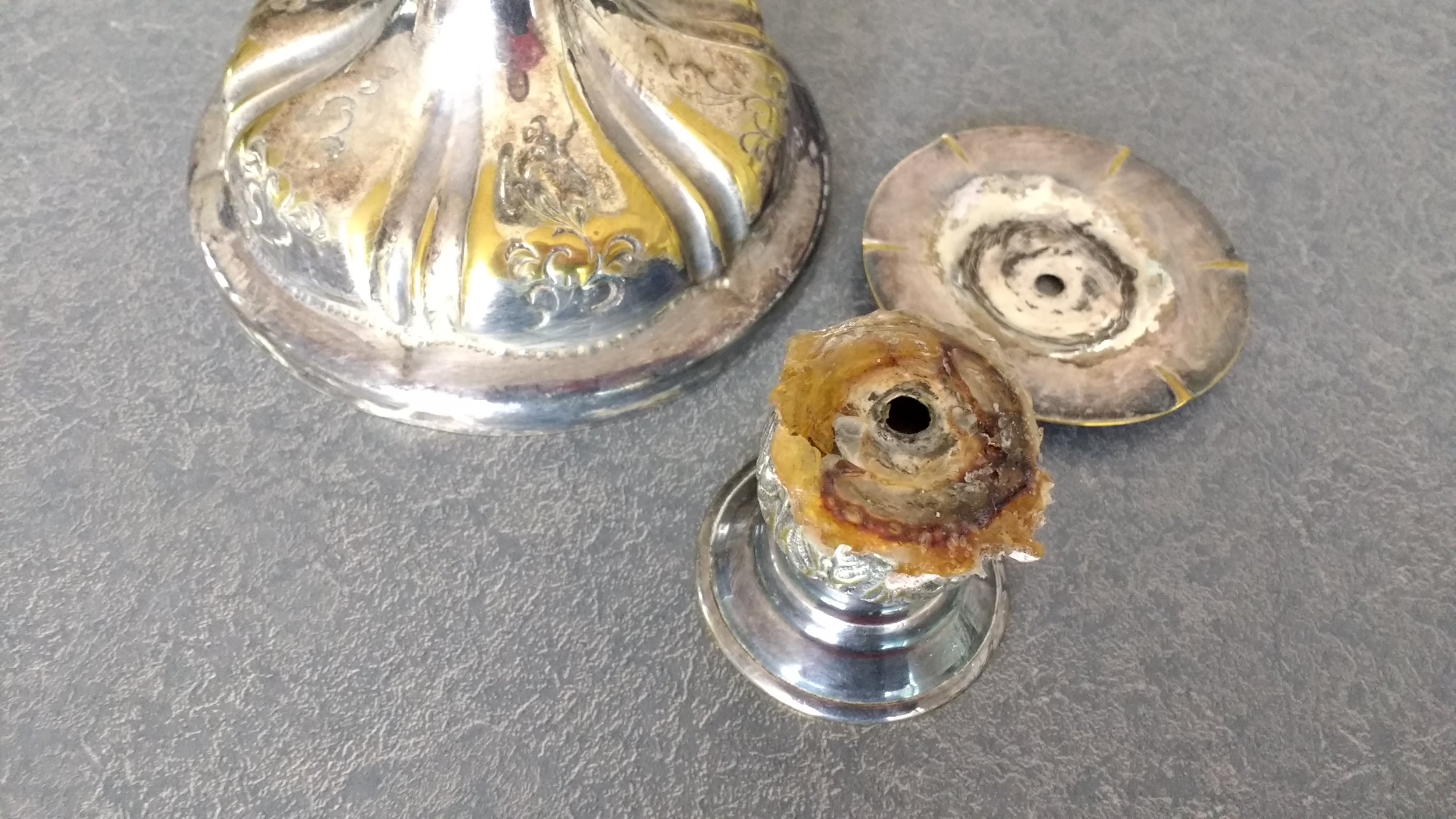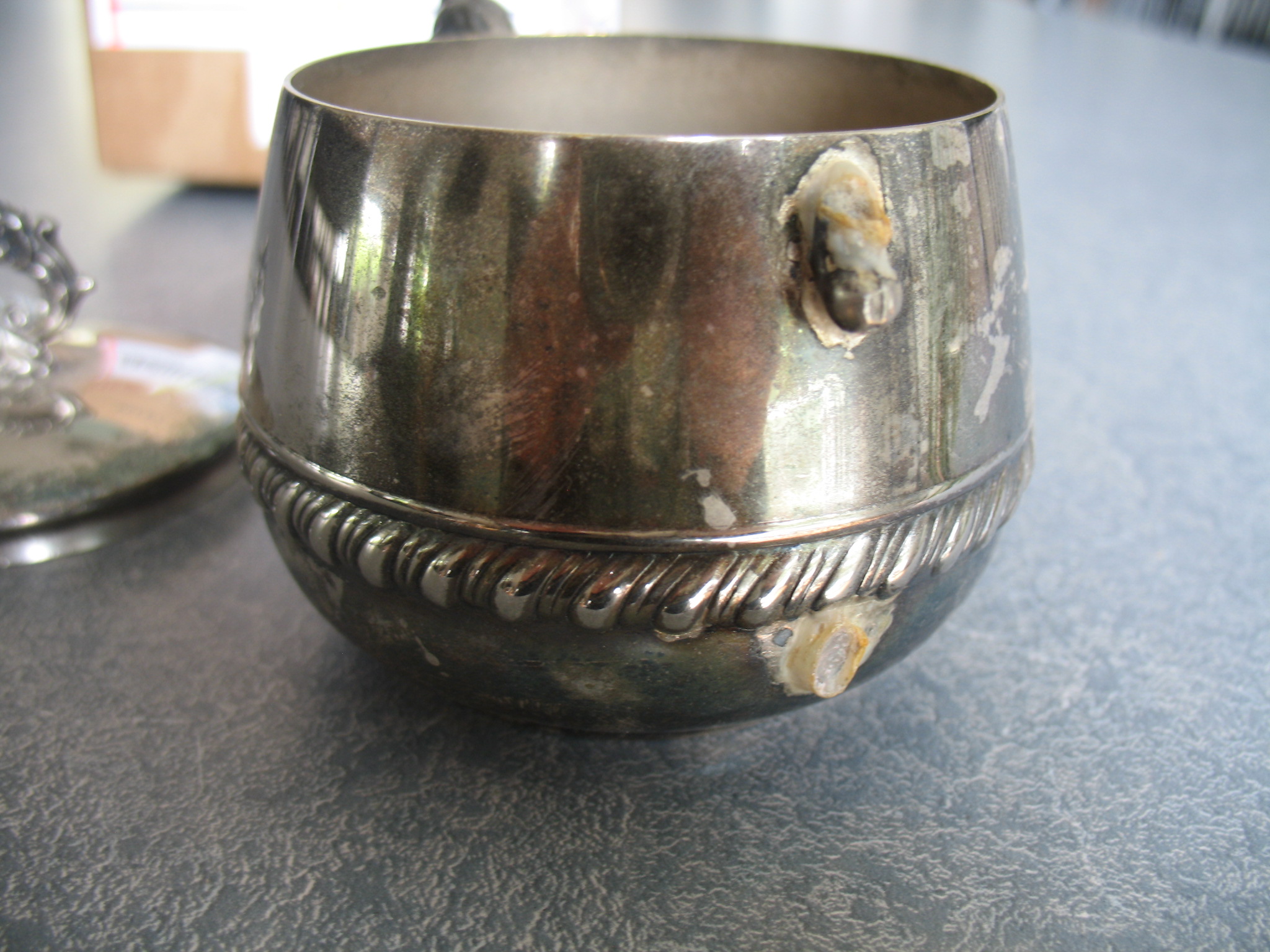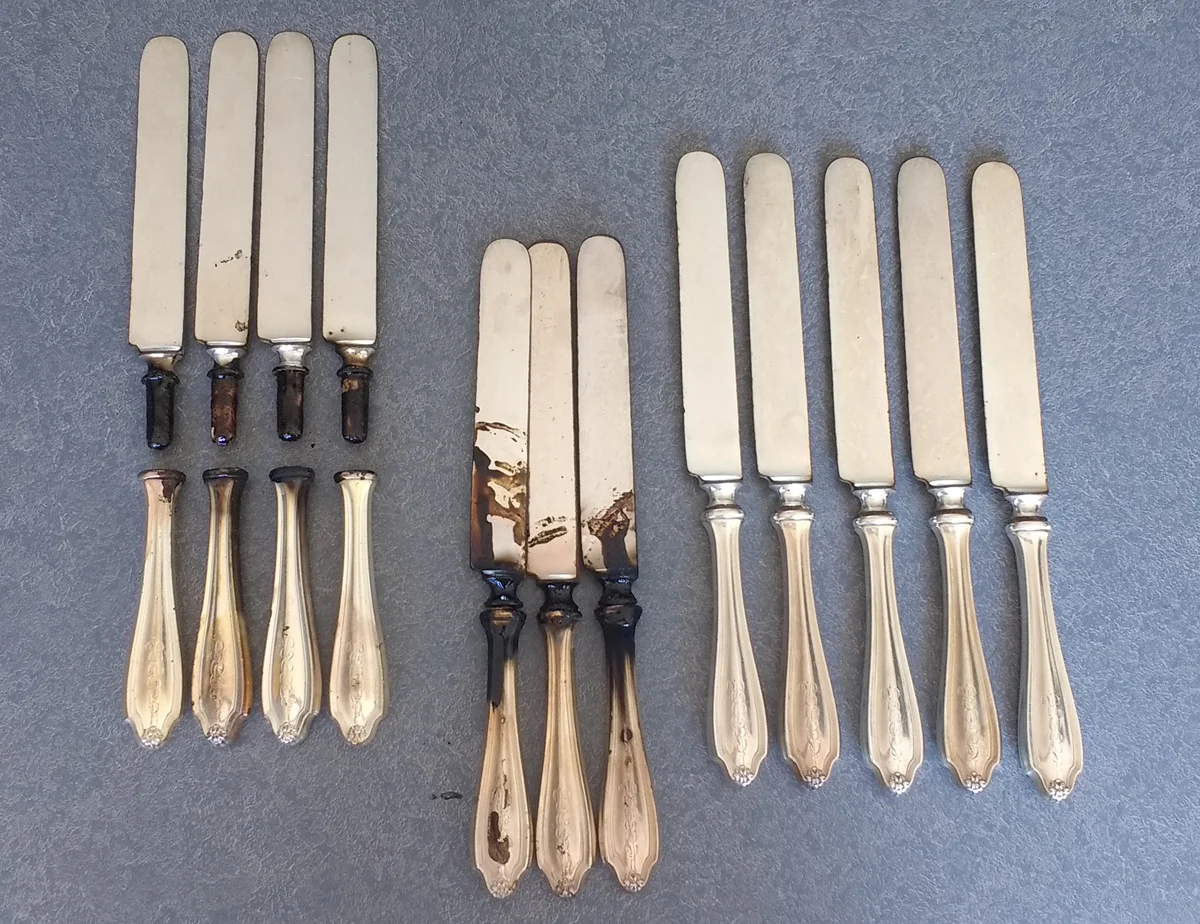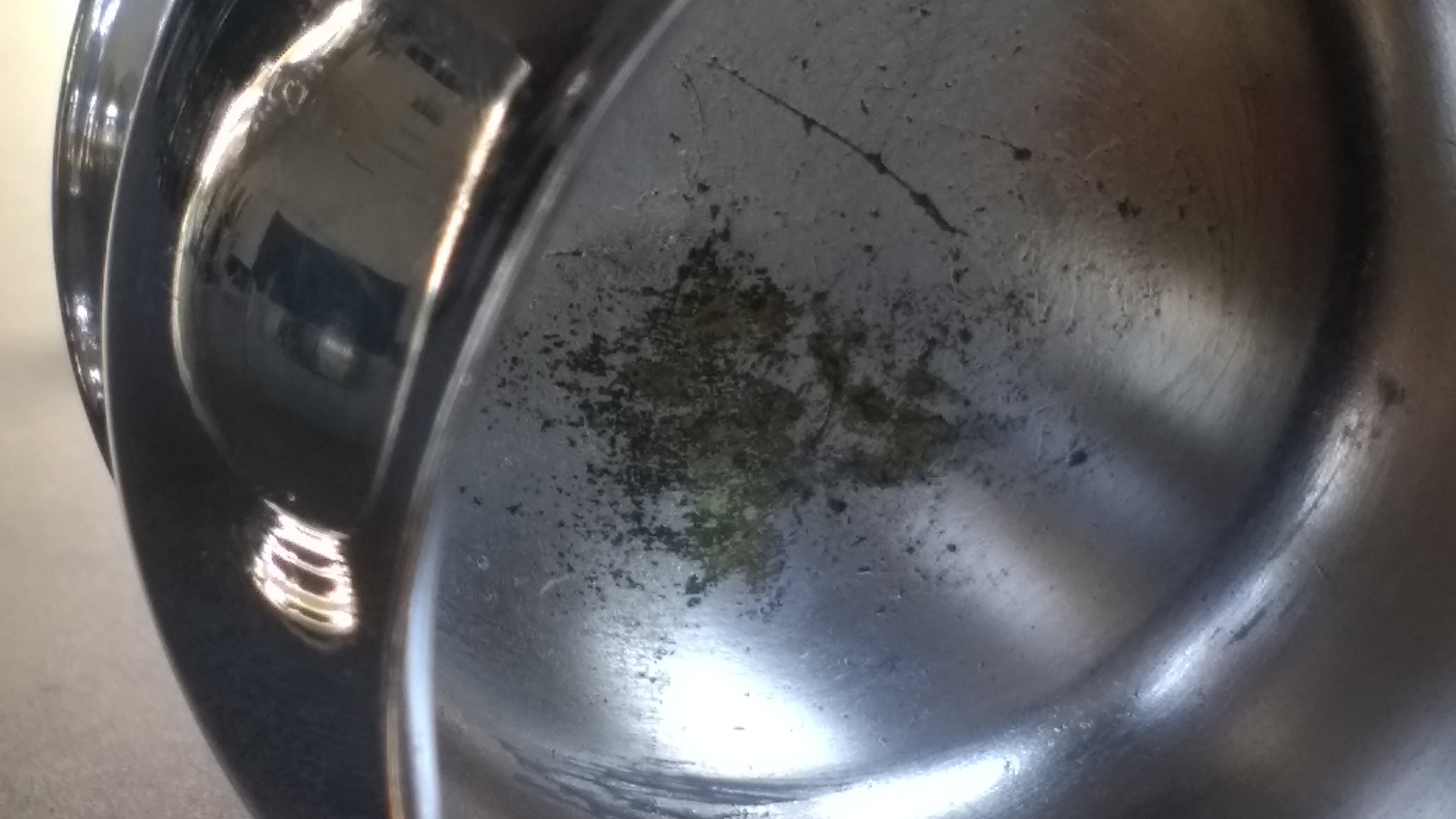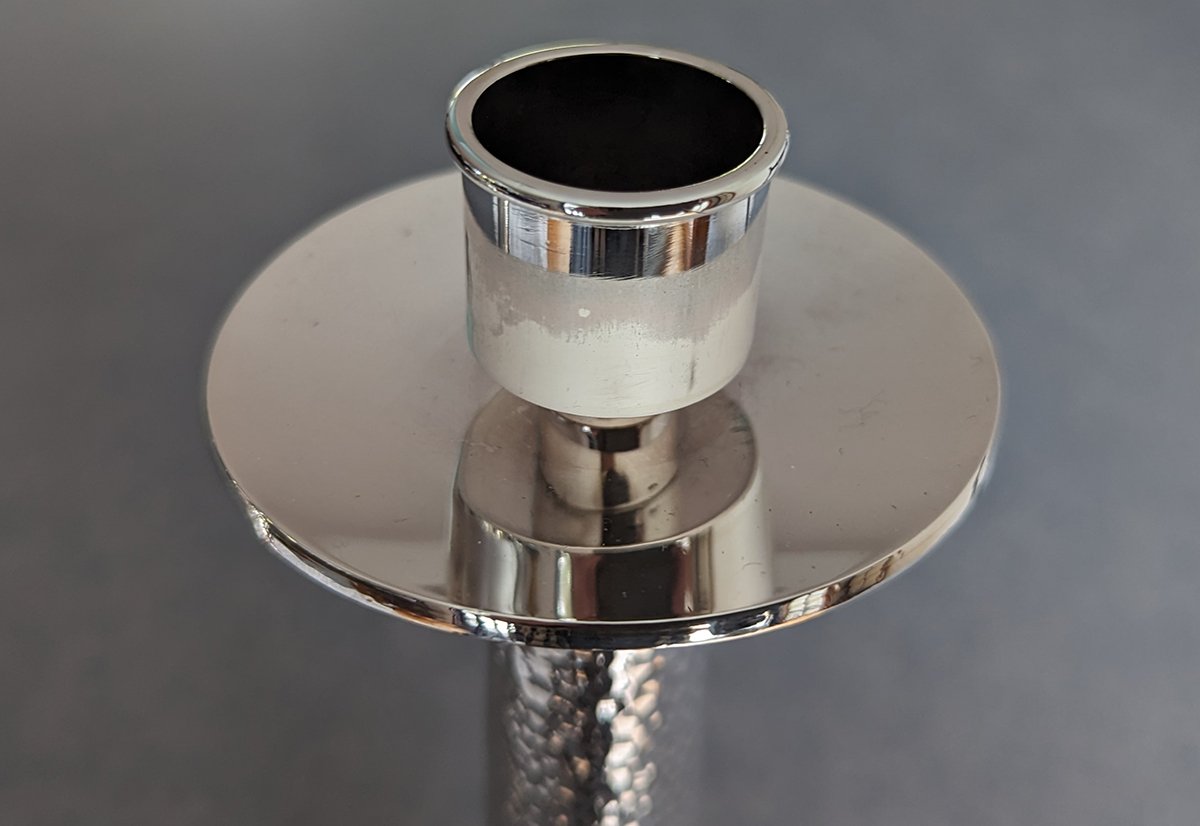Never use Tarn-X or Aluminum Foil Recipes to remove tarnish!
Tarn-X and aluminum foil recipes for removing tarnish on your silver
Never use Tarn-x or aluminum foil recipes to remove tarnish from your sterling silver or silver plate. The solution will actually etch into the surface. On sterling silver these solutions etch into the surface, leaving a frosty white texture (as shown in the above photo.) This frosty texture must be aggressively polished professionally to refinish. Because of the significant time and effort required, it costs more than if you had me polish your silver.
On silver plate, Tarn-X and the aluminum foil recipes actually eat into the silver plating, removing the plating down to the base metal.
When items are left in the Tarn-X or aluminum foil for a few hours or overnight it causes significant damage. Never use these formulas.
Will glue work to repair Silver?
QUESTION: Does it work to glue my silver? What kind of glue can I use?
ANSWER: Glue never works to repair silver. It doesn't matter what the glue package promises, it won't work and it will look ugly. However, the glue may stick to the silver and can be very challenging to remove before the repair. Sometimes it even affects the flow of the solder and the neatness of the repair. Please do not glue sterling silver or silverplate. It won't be strong enough, and the repair will cost more because I have to spend so much time carefully removing the glue.
There is no solvent for removing dried glue. It has to be carefully picked off one speck of glue at a time.
Care for sterling and silverplate knives.
QUESTION: Can I put my silver knives in the dishwasher?
ANSWER: Sterling and silver plate knives should NOT be put in the dishwasher. Ever!
This is because the knife blade is usually held inside the hollow handle with a resin/asphaltum pitch material.
If the core of the knife handle gets too hot in the dishwasher from either hot water or the heat during the dry cycle, the pitch inside the handle may loosen and push the knife blade out of the handle.
QUESTION: My sterling silver knife handles are loose? Can they be repaired?
ANSWER: Knife blades can be reset into the handle but it is time consuming and messy process. The blades must be completely removed and reset. I always solder the blades to the handle so they do not become loose again.
QUESTION: The knife blades on my sterling silver handles look corroded & rusty? Can you fix these?
ANSWER: Knife blades (pre-WWII) were often silver-plated steel. ) Over time, the steel starts to rust and the silver plating peels off. The knife blades can not be replated, but can be replaced with a new stainless steel knife blade in a similar style. Other repair options include polishing the steel.
How can I tell if the Silverplating
is Too worn?
Silver plated ladle with plating worn through to the base metal
In the photos above, the silver plating on the ladle is worn through to the base metal. This is most obvious on the back of the bowl, where most of the wear occurred, but the inside of the ladle also had deep wear and scratches. Look closely at your silver plate. Wear through the silver plating that shows the base metal means that new silver plating may be necessary. The photo below shows the ladle after new silver plating. (I do not do any silver plating but will either make a recommendation for silver plating, or take it in for you.)
Can corrosion in Silver Plate be polished
Can corrosion in silver plate be polished?
Corrosion in the silver plate can not be polished out without new silver plating. This corrosion as shown in the photo (above) has damaged the silver plating. Touch the surface and it will feel textured. There is nothing that can be done except silver plating. I do not do silver plating but can make a recommendation. Silver plating is expensive. This is not a cost-saving measure. Silver plating is an investment in family treasures or beautiful objects.
Purple Silver Stain - Firescale
Sometimes silver has a stain or discoloration in the silver. Can this be polished off?
Silver will develop what is called firescale when it is heated for annealing (during fabrication) or soldering. It is not just on the surface but can be deeper in the metal. I often see firescale on antique silver that was fabricated in less controlled situations or on newly fabricated silver (as shown above. On new silver, the firescale develped during fabrication is often silver plated, but the silver plating eventually wears off revealing the firescale.
Generally, I do not remove firescale during repairs and restoration because I have to polish the silver too aggressively. I think it is best to consider the firescale part of the history of the silver. Generally, the firescale is only visible if there is a reflection from a white piece of paper.
Q&A about Silver Care from my clients.
QUESTION: Is there anything I should do differently when cleaning/polishing silver plate vs sterling flatware? I am recently remarried and between my first husband's family and my current husband's family I have 4 full sets of flatware and 3 partial sets of flatware.
ANSWER: Polish silver and silverplate exactly the same way: by hand. Be very careful to only put away silver when it is clean and dry. If the flatware was on the table, it should always be washed even if it was not used just to insure there is no food on the silver. Food, especially salt, can ruin the polished finish of your flatware. View my silver polishing instructions by clicking here.
QUESTION: Some of the serving pieces from my husband's family have something that looks like corrosion on them in addition to the tarnish. Do you know what this might be? Is it dangerous? Is there anything I need to know about cleaning it off?
ANSWER: If the knives, forks, spoons, or serving pieces have black spots, they need to be polished professionally with a buffing machine using a buff and buffing compound. This is not a consumer level process as it can be dangerous. Do not try this at home! Very often these dark black spots are caused by food, especially if these silver pieces were not put away completely clean. Sterling silver serving pieces can be completely refinished. Silver plate needs to be looked at to see what can be done.
QUESTION: I have a metal plate "thingee" that you submerge in hot water and add an activating powder (baking soda or something?) and it's supposed to reverse the tarnishing on silver. Is this recommended or to be avoided?
ANSWER: AVOID all such products including those “aluminum foil recipes for removing tarnish.” It removes the oxidation in the recess of the pattern and turns the silver to a frosty white, etching the surface. The silver will still not be polished, and definitely looks unattractive. Dips like this etch the surface and can eat off silverplate. Do not use dips or recipes to remove tarnish.
QUESTION: How should I store my sterling salt and pepper shakers?
ANSWER: If your won't be using your silver salt shakers every day, I recommend removing the salt from the salt shakers. Wash the salt shaker with soapy water inside and out, including the lids. Let them drain upside down over night before putting them away to make sure they are completely dry. Silver cloth bags are best for preventing tarnish. They come in all different sizes.
The pepper will not damage your sterling silver pepper shaker between uses. There is no reason to remove the pepper.
QUESTION: What silver polish do you recommend?
ANSWER: I like 3M Tarnish Shield which you can buy online.
Q&A About marks on silver
QUESTION: What does E.P.N.S. mean? It is stamped on the bottom of my silver.
ANSWER: E.P.N.S. stands for "Electro-Plate Nickel Silver. This means it is silver plate on nickel silver. Nickel silver is a white brass alloy that contains no silver content at all, despite its name.
QUESTION: What does 925 mean stamped on the bottom of my silver baby cup.
ANSWER: 925 is Sterling Silver. This means it is 925 parts silver to 75 parts alloy (usually copper.) This is the standard for sterling silver in the United States.
QUESTION: What does a lion stamped on the bottom of my silver indicate?
ANSWER: A lion stamp is the British mark for sterling silver.
QUESTION: What is 800 mean stamped into my silver?
ANSWER: 800 is an alloy of silver. It is more common in older European silver work. This means it is 800 parts silver to 200 part alloy.
QUESTION: How do I know if my silver is sterling silver or silverplate?
ANSWER: Usually sterling is marked with a quality mark such as STERLING, 925, or a LION (see above.) The quality marks are usually on the bottom, or on the bottom edge. On a chalice the quality mark may be near the top edge. Quality marks, hallmarks, and maker marks can be very small and difficult to read. Silver from countries other than the U.S. or England may have a quality mark that is difficult to recognize.
Silverplate can sometimes be identified by looking for wear on the prominent areas of the design. You will be able to see the base metal wear the silver plating is wearing off. Base metals are usually, copper, brass, white brass (commonly referred to as nickel silver) or a pot metal.
QUESTION: I just inherited Meriden Silver Plate from my family. Can you tell me more about silver plate?
ANSWER: Silver plating was invented in about 1840. By about 1875, there are a thriving silver plate industry offering lower cost silver plate items for a growing middle class. Meriden Silver Plate was one of many companies offering a wide selection of silver plated items in their catalogs which I love to look at. Popular items at the time included water pitchers, castor sets, and butter dishes.
Here is a link to a catalog for Meriden Silver Plate Catalog 1883
This second link is to a catalog for Meriden Britannia Company 1`886-7
QUESTION: What is quadruple plate?
ANSWER: Quadruple Plate is silver plate. This term was often used in the 19th and early 20th century with the idea of selling quality silver plate. Is it really quality? That is hard to say when you are looking at 100 year old silver, but in comparison, most new silverplate is cheaply made and not quality. I'd recommend buying older pieces at antique stores or e-bay and have them polished and repaired as needed.
Removing Engraving in Silver
QUESTION: Can you remove engraving from my silver?
ANSWER: Removing engraving is a complex issue. Here are a few considerations.
If the item is silverplate, removing the engraving will ruin the plating thus requiring new silverplating. Another consideration is that if this is an inexpensive 20th/ 21st century silverplated item, it may not be worth replating.
If the engraving is machine engraving, the engraving may be shallow, and easy to remove in sterling. Silverplate will always require new silver plating.
If the engraving is hand engraved, the engraving actually cuts quite deeply into the silver. Removing the engraving may be possible, but might make the silver very thin. Another option is a new technology using a laser welder which fills in the silver engraving. Please inquire about this option.
While this is a brief commentary about removing engraving, it isn't a comprehensive description of the issue. Please feel welcome to contact me by email or phone so that you can send me photos for more insight.
I have one final thought. The engraving is part of the character and history of the silver work. If it is family silver or antique silver passed down through the generations, perhaps instead of removing the engraving, consider adding engraving to the silver in another area. For example, for a sterling baby cup, add a name to the other side.
Q&A About Ivory
QUESTION: Can you replace or repair the ivory insulators on my teapot?
ANSWER: Ivory is now considered illegal in an effort to curb the killing of elephants. For your teapot or coffeepot, if the ivory insulator is just a little loose and not broken, perhaps all that is needed is to replace the rivet. Or, if you don't plan on using the teapot, perhaps it could be reinforced with some industrial epoxy.
If the ivory insulators are broken, they can be replaced with an off-white industrial plastic called Delrin or imitation ivory that is also a type of plastic. Each insulator has to be hand carved for replacement which makes this a time-consuming, labor-intensive process. I'd estimate a minimum of $850 or more.
Black ebony insulators can be hand carved from black Delrin. I have carved new black Delrin insulators and they looked exactly like the old ebony insulators.
QUESTION: Where can I learn more about the issues surrounding ivory and how it affects resale or estates?
ANSWER: Recently the law has been extended to prohibit selling all items containing ivory. "At issue are small amounts of ivory in pianos, antique furniture, violin bows, jewelry, knives, clocks, canes, sculpture, silver teapots, pens, guns and even billiard cues. New rules and enforcement guidelines may render these items not only illegal to export or import, but also unsellable within the United States including piano or decorative inserts on bows or furniture." Read more about this issue in this article titled "Zero Fair Market Value for Antiques?" by Patricia Atwood on the WealthManagement.com website.
Antiques Roadshow also provides information about ivory in antique and vintage items.

